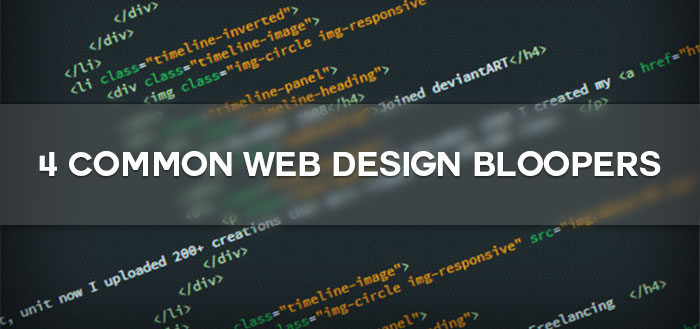
You can find a dozen of websites online, and new ones keep sprouting up each day. And thus, to create a website that gets easily noticed by your target audience in today’s fickle marketplace can be a daunting task.
When it comes to crafting a web design, most of the designers (especially novices) often become overwhelmed and focus on creating a good-looking website design, but overlook the most important aspect: usability. No doubt, a web design must look visually appealing, but you shouldn’t forget that the site is meant to resolve the user’s needs.
In this post, we’ll highlight 4 of the common blunders web designers make and a few suggestions how they can be avoided.
1. Slow Server Response Time
The time between the request a browser sends to the web server, and the response your server returns is called as “Server Response Time”. Slow server response time leads to slow page loading speed – which is unacceptable with professional sites – as it increases a page abandonment rate. There can be many reasons that cause delay in the server’s response to a browser’s request such as loading large-size images or special add-ons, etc.
Suggestion:
Using less resources (like CSS, JavaScript, etc.) will put less stress on the web server, and will make the page load quickly. For this purpose, follow these steps:
- Use “Lazy Load Techniques” to optimize image performance.
- Combining external CSS files into one calls for less page resources and more.
2. Difficult to Understand Navigation
If your website visitors cannot figure out where they need to move next on your site quickly, they’ll most likely head to another website (ideally your competitor’s site). Whenever users visit a site for the first time, they expect to be guided about how they can easily navigate throughout the site.
Suggestion:
Make sure that your website navigation menu is easily accessible and comprehensible at the same time. Always place the navigation bar at the top of the page, so that it will be visible to visitors when they “get in” your site. What’s more? Include a simple sitemap in the your website navigation bar and/or footer, for providing a quick glance of all your web pages.
3. Using Bizarre Font Styles and Sizes
Of course, creating an appealing interface design would helps in brining the attention of the user’s towards your website. But, if the users are finding difficulty in reading the text they won’t take time in hitting your website back button to exit from it. But, an unfortunate reality is that several sites contain font styles and sizes, making it difficult for users to read the text.
Suggestion:
Following the below mentioned tips can help you improve your visitors reading experience:
- Look at other popular sites working in the same domain as yours, and observe the color schemes that help in improving readability.
- Make use of latest practiced typeface such as Sans serif, as it helps take put the pain from reading.
- Balance font-size and line height.
4. Unfriendly Screen Size and Resolution
You might have come across sites wherein you need to scroll horizontally to access the rest of the website content. But, this is no longer the case with the modern web designs. In simple words, make sure to create designs keeping in mind the screen size and resolution of the target device. The ideal resolution of your website layout should be “1024 x 768” pixels.
Suggestion:
Thinking about creating a design that fits all screen sizes and resolutions, especially when users are switching from a desktop to mobile devices isn’t easy. Thankfully, you can get a rough idea about the most commonly preferred screen resolutions using the below mentioned ways:
- You can use Google Analytics to obtain information about the resolution of the device your website users are using. And accordingly, you can design the layout that best fits a user’s device screen resolution.
- W3 Schools provide the list of the most popular browser that people use to access the web, and also help them sort according to popularity.
The Bottom Line
You don’t need to make your web design over-boarded with too many fancy elements and components. Rather keep your website layout simple to understand and easy to navigate. Also, make sure that your web page loading speed is fast and can be properly accessed on different screen resolutions.
Author Biography:
Jack Calder is a expert professional in Markupcloud Ltd, a leading psd to html service company. Jack is working as web developer in this firm and shares his knowledge with all on the web.

That superscript-9-as-an-apostrophe is super distracting.
Sorry, about that, I see that is a problem with the ubuntu font from Google Fonts.
https://wordpress.org/support/topic/apostrophe-appearing-as-superscript-9-in-tinymce-editor
Bummer!
Thank you for the feedback, I changed the font to open sans.